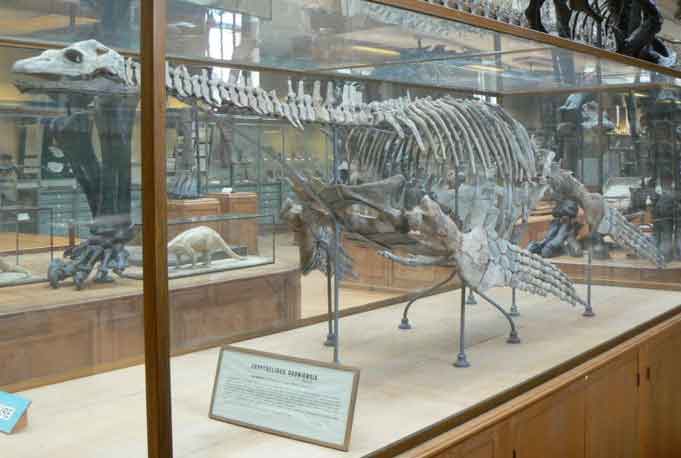
Cryptoclidus oxoniesis, Muséum national d'Histoire naturelle, Pari
| Cryptoclidus Fossil range: Middle Jurassic |
||||||||||||||||
|---|---|---|---|---|---|---|---|---|---|---|---|---|---|---|---|---|
| Scientific classification | ||||||||||||||||
|
Cryptoclidus (crip-TOE-clide-us) was a genus of plesiosaur (a type of marine reptile) from the Middle Jurassic Period of England.
Discovery
Cryptoclidus is one of the best-known plesiosaurs. Specimens include adult and juvenile skeletons, and remains, in various degrees of preservation, have been found in England, Northern France, Russia, and South America. Its name, meaning "hidden clavicles", refer to its small, practically invisible clavicles buried in its front limb girdle.
The type species, was initially described as Plesiosaurus eurymerus by Phillips (1871). The species name "wide femur" refers to the forelimb, which was mistaken for a hindlimb at the time.
Appearance
It is estimated to have weighed about 8 tons. Its head was rather flattened, with eyes facing upward. The skull was broad and light, with jaws lined with about a hundred long, fine teeth. The internal nares were set forward, and the nostrils were relatively small. At up to 8 metres(27 ft) long, Cryptoclidus was a medium-sized plesiosaur.
It had a neck that was up to 2 metres long that did not seem to have been very flexible. It probably kept its bulky body away from its small head so as not to alarm potential prey. It had long pointed teeth, ideal for catching fish and squid. It had four broad paddle-shaped limbs, with which it either "flew" through the water in wave-like undulating movements, or swam like a porpoise by moving upwards on two flippers and gliding back down again on the other two.
Lifestyle and Feeding
Due to their seal-like body plan, small plesiosaurs such as Cryptoclidus have been depicted as amphibious animals instead of fully marine reptiles. Despite looking clumsy and cumbersome, in water it would have become a thing of grace, using all four limbs as paddles, to swim and hunt its prey. It may have laid eggs in sand, but this is conjectural.
The fragile build of the head and teeth preclude any grappling with prey, and suggest a diet of small, soft-bodied animals such as squid and shoaling fish. Cryptoclidus may have used its long, intermeshing teeth to strain small prey from the water, or perhaps sift through sediment for buried animals.
The size and shape of the nares and nasal openings have led Brown and Cruickshank (1994) to argue that they were used to sample seawater for smells and chemical traces.
In popular culture
* Like many prehistoric creatures, Cryptoclidus was featured in the BBC television series Walking with Dinosaurs. In the show, it was presented as a seal-like animal coming up on land to rest and diving to catch fish in the water.
* A giant mutant plesiosaur from Godzilla: The Series takes its name from this creature.
Retrieved from "http://en.wikipedia.org/"
All text is available under the terms of the GNU Free Documentation License

